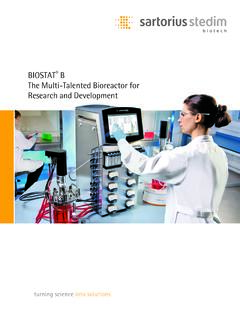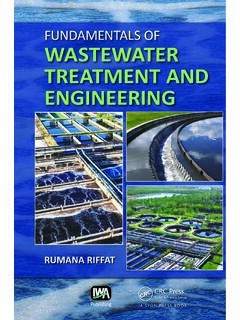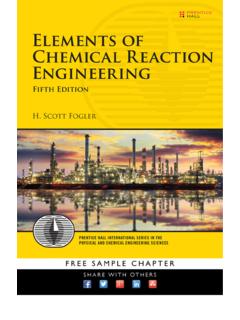Transcription of An Overview of Fermenter and the Design Considerations to ...
1 Pharmacologyonline 1: 261-301 (2010) Newsletter Jagani et al. An Overview of Fermenter and the Design Considerations to Enhance Its Productivity Hitesh Jagani*, Karteek Hebbar, Sagar S. Gang, P. Vasanth Raj, Raghu Chandrashekhar H. and Rao. Department of Pharmaceutical Biotechnology, Manipal College of Pharmaceutical Sciences Manipal University, Manipal, Karnataka, India. The function of the Fermenter or bioreactor is to provide a suitable environment in which an organism can efficiently produce a target product the target product might be cell biomass, metabolite and bioconversion Product. It must be so designed that it is able to provide the optimum environments or conditions that will allow supporting the growth of the microorganisms. The Design and mode of operation of a Fermenter mainly depends on the production organism, the optimal operating condition required for target product formation, product value and scale of production.
2 The choice of microorganisms is diverse to be used in the fermentation studies. Bacteria, Unicellular fungi, Virus, Algal cells have all been cultivated in fermenters. Now more and more attempts are tried to cultivate single plant and animal cells in fermenters. It is very important for us to know the physical and physiological characteristics of the type of cells which we use in the fermentation. Before designing the vessel, the fermentation vessel must fulfill certain requirements that is needed that will ensure the fermentation process will occur efficiently. Some of the actuated parameters are: the agitation speed, the aeration rate, the heating intensity or cooling rate, and the nutrients feeding rate, acid or base valve. Precise environmental control is of considerable interest in fermentations since oscillations may lower the system efficiency, increase the plasmid instability and produce undesirable end products.
3 This review gives the complete information about Fermenter and parameters to be considered to enhance its productivity. Key words: bioreactor , Fermenter , impeller, sparger, and aspect ratio. *Corresponding Author: E-mail: 261. Pharmacologyonline 1: 261-301 (2010) Newsletter Jagani et al. 1. Introduction: - Fermentation technology: - Fermentation Technology could be defined simply as the study of the fermentation process, techniques and its application. Fermentation should not be seen merely as a process that is entirely focused on the happenings occurring in the Fermenter alone! There are many activities that occur upstream leading to the reactions that occur within the bioreactor or Fermenter , despite the Fermenter is regarded as the heart of the fermentation process. Fermentation technology is the whole field of study which involves studying, controlling and optimization of the fermentation process right up from upstream activities, mid stream and downstream or post fermentation activities.
4 The study of fermentation technology requires essential inputs from various disciplines such as biochemistry, microbiology, genetics, chemical and bioprocess engineering and even a scatter of mathematics and physics. Fermentation in terms of biochemistry and physiology:- Fermentation is now defined as a process of energy generation by various organisms especially microorganisms. The fermentation process showed unique characteristics by which it generates energy in the absence of oxygen. The process of energy generation utilizes the use of substrate level phosphorylation (SLP) which do not involved the use of electron transport chain and free oxygen as the terminal electron acceptor. Engineers definition of fermentation:- It is only up to recently with the rise of industrial microbiology and biotechnology that the definition of fermentation took a less specific meaning.
5 Fermentation is defined more from the point of view of engineers. They see fermentation as the cultivation of high amount of microorganisms and biotransformation being carried out in special vessels called Fermenter or bioreactors. Their definitions make no attempt to differentiate whether the process is aerobic or anaerobic. Neither are they bothered whether it involves microorganisms or single animal or plant cells. They view bioreactors as a vessel which is designed and built to support high concentration of cells. 262. Pharmacologyonline 1: 261-301 (2010) Newsletter Jagani et al. bioreactor : - Also known as Fermenter . A bioreactor is a specially designed vessel which is built to support the growth of high concentration of microorganisms. It must be so designed that it is able to provide the optimum environments or conditions that will allow supporting the growth of the microorganisms.
6 Bioreactors are commonly cylindrical vessels with hemispherical top and/or bottom, ranging in size from some liter to cube meters, and are often made of stainless steel and glass. The difference between a bioreactor and a typical composting system is that more parameters of the composting process can be measured and controlled in bioreactors. The sizes of the bioreactor can vary over several orders of magnitudes. The microbial cell (few mm3), shake flask (100-1000 ml), laboratory Fermenter (1 50 L), pilot scale ( 10m3) to plant scale (2 500 m3) are all examples of bioreactors. The Design and mode of operation of a Fermenter mainly depends on the production organism, the optimal operating condition required for target product formation, product value and scale of production. The Design also takes into consideration the capital investment and running cost.
7 Large volume and low value products like alcoholic beverages need simple Fermenter and do not need aseptic condition. High value and low volume products require more elaborate system of operation and aseptic condition. Bioreactors differ from conventional chemical reactors in that they support and control biological entities. As such, bioreactor systems must be designed to provide a higher degree of control over process upsets and contaminations, since the organisms are more sensitive and less stable than Chemicals. Biological organisms, by their nature, will mutate, which may alter the biochemistry of the bioreaction or the physical properties of the organism. Analogous to heterogeneous catalysis, deactivation or mortality occur and promoters or coenzymes influence the kinetics of the bioreaction. Although the majority of fundamental bioreactor engineering and Design issues are similar, maintaining the desired biological activity and eliminating or minimizing undesired activities often presents a greater challenge than traditional chemical reactors typically require.
8 Other key differences between chemical reactors and bioreactors are selectivity and rate. In bioreactors, higher selectivity that is, the measure of the system's capability for producing the preferred product (over other outcomes) is of primary importance. In fact, selectivity is especially important in the production of relatively complex molecules such as antibiotics, steroids, vitamins, proteins and certain sugars and organic acids. Frequently, the activity and desired selectivity occur in a substantially smaller range of conditions than are present in 263. Pharmacologyonline 1: 261-301 (2010) Newsletter Jagani et al. conventional chemical reactors. Further, deactivation of the biomass often poses more severe consequences than a chemical upset. The Designing of a bioreactor also has to take into Considerations the Unique Aspects of Biological Processes a.
9 The concentrations of starting materials (substrates) and products in the reaction mixture are frequently low; both the substrates and the products may inhibit the process. Cell growth, the structure of intracellular enzymes, and product formation depend on the nutritional needs of the cell (salts, oxygen) and on the maintenance of optimum biological conditions (temperature, concentration of reactants, and pH) within narrow limits. b. Certain substances inhibitors effectors, precursors, metabolic products influence the rate and the mechanism of the reactions and intracellular regulation. c. Microorganisms can metabolize unconventional or even contaminated raw materials (cellulose, molasses, mineral oil, starch, wastewater, exhaust air, biogenic waste), a process which is frequently carried out in highly viscous, non-Newtonian media. d.
10 In contrast to isolated enzymes or chemical catalysts, microorganisms adapt the structure and activity of their enzymes to the process conditions, whereby selectivity and productivity can change. Mutations of the microorganisms can occur under sub optimal biological conditions. e. Microorganisms are frequently sensitive to strong shear stress and to thermal and chemical influences. f. Reactions generally occur in gas-liquid -solid systems, the liquid phase usually being aqueous. g. The microbial mass can increase as biochemical conversion progresses. Effects such as growth on the walls, flocculation, or autolysis of microorganisms can occur during the reaction. h. Continuous bioreactors often exhibit complicated dynamic behaviour. Requirements of Bioreactors Due to above mentioned demands made by biological systems on their environment, there is no universal bioreactor .







